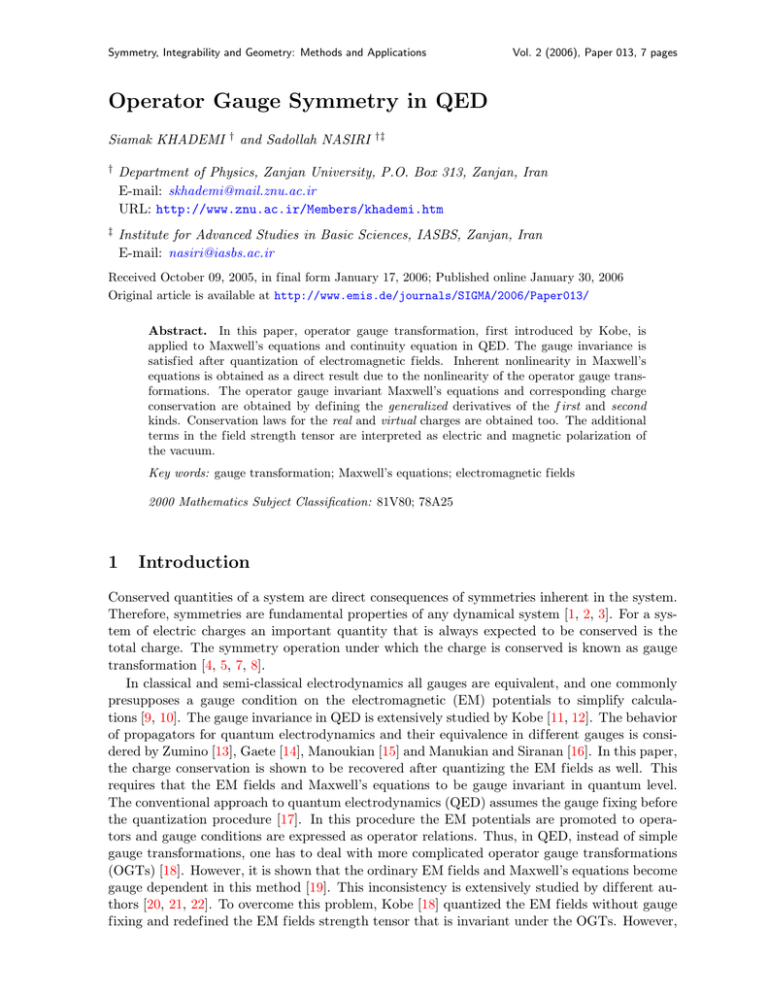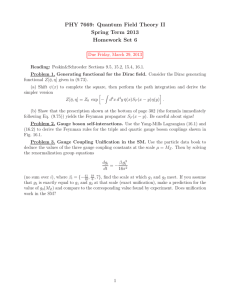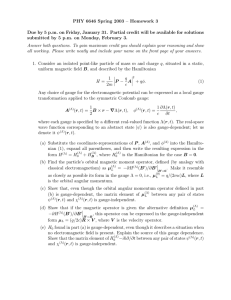Operator Gauge Symmetry in QED
advertisement

Symmetry, Integrability and Geometry: Methods and Applications Vol. 2 (2006), Paper 013, 7 pages Operator Gauge Symmetry in QED Siamak KHADEMI † and Sadollah NASIRI †‡ † Department of Physics, Zanjan University, P.O. Box 313, Zanjan, Iran E-mail: skhademi@mail.znu.ac.ir URL: http://www.znu.ac.ir/Members/khademi.htm ‡ Institute for Advanced Studies in Basic Sciences, IASBS, Zanjan, Iran E-mail: nasiri@iasbs.ac.ir Received October 09, 2005, in final form January 17, 2006; Published online January 30, 2006 Original article is available at http://www.emis.de/journals/SIGMA/2006/Paper013/ Abstract. In this paper, operator gauge transformation, first introduced by Kobe, is applied to Maxwell’s equations and continuity equation in QED. The gauge invariance is satisfied after quantization of electromagnetic fields. Inherent nonlinearity in Maxwell’s equations is obtained as a direct result due to the nonlinearity of the operator gauge transformations. The operator gauge invariant Maxwell’s equations and corresponding charge conservation are obtained by defining the generalized derivatives of the f irst and second kinds. Conservation laws for the real and virtual charges are obtained too. The additional terms in the field strength tensor are interpreted as electric and magnetic polarization of the vacuum. Key words: gauge transformation; Maxwell’s equations; electromagnetic fields 2000 Mathematics Subject Classification: 81V80; 78A25 1 Introduction Conserved quantities of a system are direct consequences of symmetries inherent in the system. Therefore, symmetries are fundamental properties of any dynamical system [1, 2, 3]. For a system of electric charges an important quantity that is always expected to be conserved is the total charge. The symmetry operation under which the charge is conserved is known as gauge transformation [4, 5, 7, 8]. In classical and semi-classical electrodynamics all gauges are equivalent, and one commonly presupposes a gauge condition on the electromagnetic (EM) potentials to simplify calculations [9, 10]. The gauge invariance in QED is extensively studied by Kobe [11, 12]. The behavior of propagators for quantum electrodynamics and their equivalence in different gauges is considered by Zumino [13], Gaete [14], Manoukian [15] and Manukian and Siranan [16]. In this paper, the charge conservation is shown to be recovered after quantizing the EM fields as well. This requires that the EM fields and Maxwell’s equations to be gauge invariant in quantum level. The conventional approach to quantum electrodynamics (QED) assumes the gauge fixing before the quantization procedure [17]. In this procedure the EM potentials are promoted to operators and gauge conditions are expressed as operator relations. Thus, in QED, instead of simple gauge transformations, one has to deal with more complicated operator gauge transformations (OGTs) [18]. However, it is shown that the ordinary EM fields and Maxwell’s equations become gauge dependent in this method [19]. This inconsistency is extensively studied by different authors [20, 21, 22]. To overcome this problem, Kobe [18] quantized the EM fields without gauge fixing and redefined the EM fields strength tensor that is invariant under the OGTs. However, 2 S. Khademi and S. Nasiri it can be easily shown that having the operator gauge invariance of EM fields strength tensor is not sufficient for Maxwell’s equations to be operator gauge invariant. Here, we extend the Kobe approach to obtain the operator gauge invariant Maxwell’s equations and corresponding charge conservation. It seems that the discrepancy of the gauge symmetry mentioned before is removed and the gauge invariance is preserved under the different OGTs. The non-linear gauge transformation as a subset of non-linear transformations is investigated by Doebner et al [23] and Goldin et al [24]. They describe an inherently linear system by non-linear dynamical equations. Thus, the non-linearity in Maxwell’s equations obtained in this paper is a direct consequence of the fact that the operator gauge transformations are non-linear transformations. Furthermore, the classical electromagnetic fields as Abelian gauge fields are promoted to non-Abelian gauges in QED. Thus, the operator gauge invariant Maxwell’s equations become mathematically similar to Yang–Mills fields. The additional commutators in quantized electric and magnetic fields are expressed as electric and magnetic polarization, although they are gauge dependent. The layout of this paper is as follows. In Section 2, after a brief review of semi-classical electrodynamics as well as the corresponding gauge transformations, the concept of operator gauge transformations is introduced. The generalized Maxwell’s equations and conservation law for electric charge are given. In Section 3, the polarization of vacuum is discussed and the last section is devoted to conclusions and results. 2 Operator gauge invariant formulation of QED In semi-classical electrodynamics the charged particles are quantized and their dynamics is described by the Schrödinger equation H|ψ(r, t)i = i~ ∂ |ψ(r, t)i, ∂t (1) while the EM fields are still classical. In equation (1) one has H= 1 q 2 P − A + qφ + V, 2m c where Aµ = (φ, −A) and V is non-electromagnetic potentials. For charged particles, the expectation value of any physical quantity G may be obtained by the averaging of the corresponding quantum mechanical operator on the state ket |ψ(r, t)i as hGi = hψ|G|ψi. The gauge transformations are described by unitary transformations as follows iqΛ(r, t) S = exp , ~c (2) which acts on the state kets as |ψ 0 i = S|ψi. (3) In equation (2) Λ = Λ(r, t) is an arbitrary smooth gauge function. If the form invariance of the Schrödinger equation under such unitary transformations is asserted, then the components of corresponding gauge transformed four potential will be A0µ = Aµ + ∂µ Λ. (4) Operator Gauge Symmetry in QED 3 In QED, in addition to the charged particles, potentials of EM fields (thereby, the EM fields themselves) are also quantized. That is, such entities must be promoted to operators, as well. In this case Maxwell’s equations are also promoted to operator equations. In general, the gauge function in equation (2) is a function of EM potentials Aµ and parameters xν Λ = Λ xν , Aµ (xν ) . Therefore, Λ is promoted to a Hermitian operator, because Aµ is now an operator. Equation (3) now becomes iqΛ(xν , Aµ (xν )) 0 |ψ i = exp |ψi. (5) ~c When the form invariance of the Schrödinger equation is assumed, one may find −1 ∂S 0 0 −1 H = H(Aµ ) = SHS + i~S , ∂t (6) where the Hamiltonian of a charged particle is given by equation (1). The operator gauge transformed potentials in equation (6) can be shown to be i~c 0 −1 S ∂µ S −1 . (7) Aµ = SAµ S + q Note that the OGT defined by equation (7) is quite different from the ordinary gauge transformations, given by (4). This is due to the fact that, in general, [Aµ , Λ(Aν (xρ ))] 6= 0 and [Λ(Aµ ), Λ̇(Aν )] 6= 0. The generalized gauge transformation of equation (7) reduces to that of equation (4) in the classical and semi-classical limits. Since the gauge symmetry is a fundamental concept in QED, all physical quantities and dynamical equations of particles and EM fields must be gauge invariant. The promotion of QED after a gauge fixing violates the gauge symmetry. However, introducing the OGTs into QED, first done by Kobe [18], ensures the gauge symmetry in quantum level. Further, a physical quantity, by its very meaning, must be unique. Therefore, for an arbitrary operator, G, to represent an observable, we demand that hψ 0 |G0 |ψ 0 i = hψ|G|ψi. (8) Using equations (5) and (8) one may obtain the OGT of any observable operator G as follows G0 (Aµ ) = G(A0µ ) = SG(Aµ )S −1 . (9) As an example it is clear that the Hamiltonian is operator gauge dependent and cannot represent −1 the observable energy, except when ∂S∂t = 0. However, it is well known that one may define the energy operator as E = H − qφ, which transforms as equation (9), under OGT. In the same manner, the field strength tensor Fµν = ∂µ Aν − ∂ν Aµ now becomes an operator which does not satisfy equation (9) under OGT, i.e. 0 Fµν 6= SFµν S −1 . 4 S. Khademi and S. Nasiri Consequently, Fµν can not be a physical quantity in the framework of the operator gauge invariant QED. To remedy this inconsistency, one may redefine the EM field strength tensor as Fµν = ∂µ Aν − ∂ν Aµ + iq [Aµ , Aν ], ~c (10) which may be easily shown to be operator gauge invariant [18]. The classical equations of EM fields, i.e., the Maxwell equations, should be transformed into operators, when the EM fields are quantized. Clearly, these equations are operator gauge dependent, therefore, it violates the gauge symmetry principle, in QED. To overcome this problem we replace the four-derivative operator ∂µ in ordinary definition of Fµν by generalized fourderivative as follows ∂µ → Dµ = ∂µ + iq Aµ , ~c (11) to ensure the gauge invariance of physical quantities in QED. From equation (11) it can be shown that the gauge transformation of the generalized four-derivative in QED obeys iq iq Dµ0 = ∂µ + A0µ = S ∂µ + Aµ S −1 = SDµ S −1 . ~c ~c Therefore, one must use the generalized four-derivative of the four potentials instead of the common derivative to define Fµν , in an operator gauge invariance formulation of QED Fµν = Dµ Aν − Dν Aµ . (12) We call Dµ as the generalized four-derivative of f irst kind. Equation (12) guarantees the operator gauge invariance of Fµν . However, this is not sufficient to preserve the gauge symmetry of the Maxwell equations in QED. To get consistency, we introduce the generalized four-derivative of the second kind as follows Dµ = ∂µ + iq [Aµ , ], ~c which operates only on the observable as Dµ G = ∂µ G + iq [Aµ , G]. ~c Thus, Maxwell’s equations regarded as dynamical equations governing the evolution of the observable in QED, take the operator gauge invariant form as follows Dµ F µν = ∂µ F µν + iq 1 [Aµ , F µν ] = j ν ~c c (13) and Dµ ∗ F µν = ∂µ ∗ F µν + iq [Aµ , ∗ F µν ] = 0, ~c where ∗ F µν = 12 µναβ Fαβ is the dual tensor corresponding to F µν . For a special class of gauge operators, where the above commutators vanish, one ends up with ordinary Maxwell’s equations. One may call this special class of gauge operators as commutative gauges, otherwise, we have non-commutative gauges. Operator Gauge Symmetry in QED 5 Furthermore, if one takes the four-divergence of ordinary inhomogeneous Maxwell’s equation, and notes that Fµν = −Fνµ , one finds, ∂µ j µ = 0, which is the conservation law of the electric charge. However, in an operator-gauge-invariant formulation of QED, taking the four-divergence of equation (13), one finds 1 ∂ν ∂µ F µν = ∂ν J ν = 0, c (14) where J ν = jν − iq [Aµ , F µν ] ~ (15) is the total unobservable four-current density. The first term on the right-hand side of equation (15) has its origin in charged particle which produces the real (gauge independent) fourcurrent density, while the second term has only the characteristic of the EM fields, which produces the virtual (gauge dependent) four-current density. Equation (14) confirms the conservation law of both real and virtual charges. If one considers that the real four-current density is an observable quantity, then Dµ j µ = ∂µ j µ + iq [Aµ , j µ ] = 0 ~c (16) will be the operator gauge invariant conservation law for real charge. Note that Dµ is the second kind derivative which operates on observable four current density. From equations (14)–(16) one finds [Aµ , j µ ] = ∂ν [Aµ , F µν ]. (17) Therefore, whenever the commutator of Aµ and j µ vanishes, equation (17) gives the conservation of virtual charge ∂ν [Aµ , F µν ] = 0. (18) Since the EM four-potentials and the four-current density act in different ket spaces, the commutator on the left-hand side of equation (17) vanishes. Therefore, for a charged particle interacting with an EM field, the virtual charge, as well as, the real charge are conserved. 3 Vacuum polarization Note that equation (10), has two operator gauge dependent terms, while their combination is operator gauge independent. The operator gauge independent electric and magnetic fields, as the elements of the real field strength tensor are as follows (Ei )new = (Ei )old − iq [φ, Ai ] ~c (19) and (Bk )new = (Bk )old − iq ijk [Ai , Aj ]. ~c (20) Consider the electric and magnetic polarization in a material medium defined by 1 1 Di = Ei + Pi 0 0 (21) 6 S. Khademi and S. Nasiri and µ0 Hk = Bk − µ0 Mk . In full QED one has a combination of equations (18)–(21) as 1 iq 1 1 (Di )new = (Ei )old − [φ, Ai ] + Pi = (Ei )old + (Pi )new 0 ~c 0 0 and µ0 (Hk )new = (Bk )old − iq ijk [Ai , Aj ] − µ0 Mk = (Bk )old − µ0 (Mk )new , ~c where (Pi )new = (Pi )old − iq0 [φ, Ai ] = (Pi )old + (Pi )vacuum ~c (22) and (Mk )new = (Mk )old + iq ijk [Ai , Aj ] = (Mk )old + (Mk )vacuum . ~cµ0 (23) In equations (22) and (23) (Pi )vacuum and (Mk )vacuum denote the electric and magnetic polarization of vacuum. Of course, the polarizations due to vacuum are gauge dependent, therefore, are not measurable. Whenever one chooses an special gauge in which the commutators in equations (19) and (20) vanish, then, the electric and magnetic polarization become hidden, i.e., the old and new electric and magnetic fields become identical. 4 Conclusions Here we emphasize that the ordinary gauge symmetry of classical electrodynamics to be preserved after quantization. Therefore, the concept of gauge transformations as a basic symmetry of classical electrodynamics, is extended to QED to obtain the OGT law of EM potentials. Expectation value of any observable, is then required to be operator gauge invariant. In this respect, a more general definition for the observable is given. The ordinary EM field strength tensor, which is an operator in QED, does not satisfy this definition and thus is no longer an observable. Therefore, the operator gauge invariant form of this tensor is required to be redefined. Using this definition, which is borrowed from Kobe, shows that the ordinary Maxwell equations and charge conservation, become operator gauge dependent. By defining the generalized four-derivatives of first and second kind, these dynamical equations are consistently expressed in an operator gauge invariant form, too. The conservation of the real, i.e., gauge independent, as well as the virtual, i.e., gauge dependent charges are shown to be satisfied. Derivation of vacuum electric and magnetic polarizations as direct consequence of operator gauge symmetry of the formalism, emerges to be operator gauge dependent quantities. Since the operator gauge transformations are, in general, non-linear gauge transformations, the operator gauge invariant Maxwell’s equations become non-linear, as well. Furthermore, the Abelian gauge fields of classical Maxwell’s equations are promoted to the non-Abelian gauges due to the operator gauge symmetry. [1] Greiner W., Müller B., Quantum mechanics: symmetries, New York, Springer-Verlag, 1989. [2] Karatas D.L., Kowalski K.L., Noether’s theorem for local gauge transformation, Am. J. Phys., 1990, V.58, 123–131. [3] Goldestein H., Classical mechanics, 2nd ed., Massachusetts, Addison-Wesley, 1980. Operator Gauge Symmetry in QED 7 [4] Cocconi G., Upper limits on the electric charge of photon, Am. J. Phys., 1992, V.60, 750–751. [5] Cheng T.P., Li L.F., Erratum “Resource letter GI-1: gauge invariance”, Am. J. Phys., 1988, V.56, 1048. [6] Kobe D.H., Gauge transformations in classical mechanics as canonical transformation, Am. J. Phys., 1988, V.56, 252–254. [7] Baxter C., Jaynes–Cummings Hamiltonian in a covariant gauge, Phys. Rev. A, 1991, V.44, 3178–3179. [8] Kobe D.H., Gauge invariant in second quantization: application to Hartree–Fock and generalized randomphase approximation, Phys. Rev. A, 1979, V.19, 1876–1885. [9] Baxter C., α-Lorentz gauge in QED, Ann. Phys., 1991, V.206, 221–236. [10] Sakurai J.J., Advanced quantum mechanics, 11th ed., New York, Addison-Wesley, 1987. [11] Kobe D.H., Yang K.H., Gauge transformation of the time evolution operator, Phys. Rev. A, 1985, V.32, 952–958. [12] Kobe D.H., Gauge transformation and the electric dipole approximation, Am. J. Phys., 1982, V.50, 128–133. [13] Zumino B., Gauge properties of propagators in quantum electrodynamics, J. Math. Phys., 1960, V.1, 1–7. [14] Gaete P., On gauge-invariant variables in QED, Z. Phys. C, 1997, V.76, 355–361. [15] Manoukian E.B., Action principle and quantization of gauge fields, Phys. Rev. D, 1986, V.34, 3739–3749. [16] Manoukian E.B., Siranan S., Action principle and algebraic approach to gauge transformations in gauge theories, Internat. J. Theoret. Phys., 2005, V.44, 53–62. [17] Mandel L., Electric dipole interaction in quantum optics, Phys. Rev. A, 1979, V.20, 1590–1592. [18] Kobe D.H., Gray R.D., Operator gauge transformation in nonrelativistic quantum electrodynamics: application to the multipolar Hamiltonian, Nuovo Cimento Soc. Ital. Fis. B, 1985, V.86, 155–170. [19] Healy W.P., Comment on “Maxwell’s equations in the multipolar representation”, Phys. Rev. A, 1982, V.26, 1798–1799. [20] Power E.A., Thirunamachandran T., Quantum electrodynamics with nonrelativistic sources. 1. Transformation to the multipolar formalism for second-quantized electron and Maxwell interacting fields, Phys. Rev. A, 1983, V.28, 2649–2662. [21] Haller K., Maxwell’s equations in the multipolar representation, Phys. Rev. A, 1982, V.26, 26–27. [22] Ackerhalt J.R., Milloni P.W., Interaction Hamiltonian of quantum optic, J. Opt. Soc. Am. B, 1984, V.1, 116–120. [23] Doebner H.D., Goldin G.A., Nattermann P., Gauge transformations in quantum mechanics and the unification of nonlinear Schrödinger equation, J. Math. Phys., 1999, V.40, 49–63. [24] Goldin G.A., Shtelen V.M., Generalization of Yang–Mills theory with nonlinear constitutive equation, J. Phys. A: Math. Gen., 2004, V.37, 10711–10718; hep-th/0401093.







